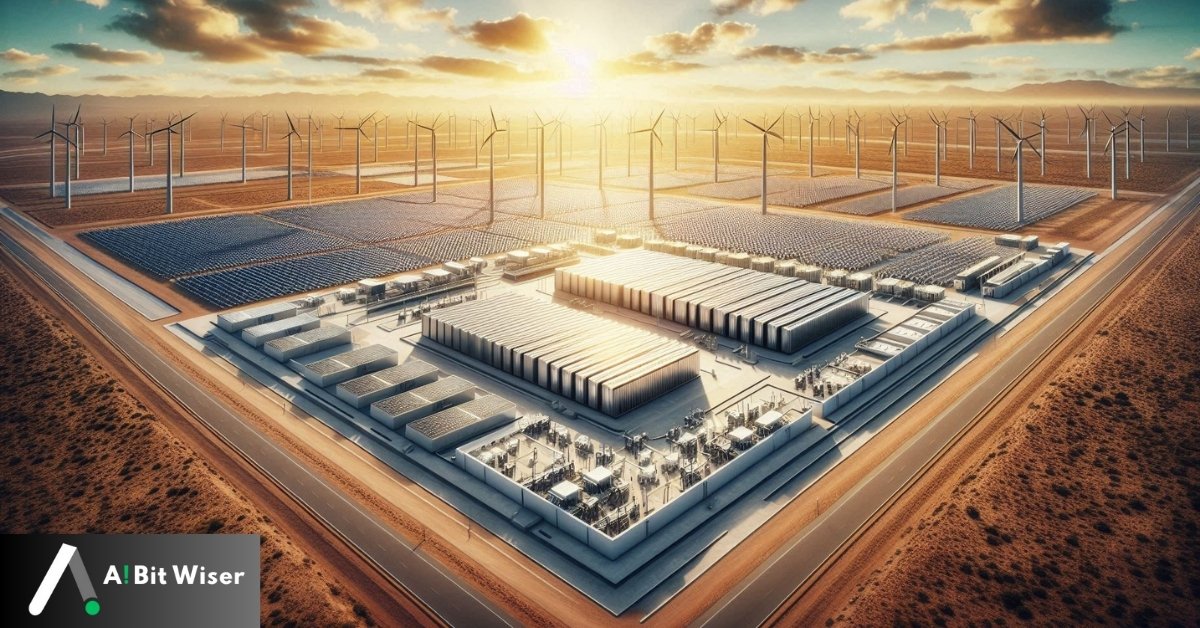Giant Batteries Are Transforming the Way the US Uses Electricity

Table of Contents
Introduction
Giant Batteries Are Transforming the Way the US Uses Electricity: The United States of America is seeing a dramatic change in the energy sector. There was never a more pressing demand for dependable and effective solutions for storing electricity thanks to the growing use of clean sources of energy like wind and solar power. Here we have gigantic batteries, sometimes referred to as large-scale energy storage devices or grid-scale batteries. These scientific advances are changing the nation’s energy systems’ resilience and lowering our dependency on fossil fuels by changing the way power is produced, stored, and consumed. This blog article will examine how massive batteries are transforming the US electrical grid, as well as the advantages and disadvantages they present economically and in terms of their prospects.

The Rise of Giant Batteries
Definition and Purpose
Grid-scale batteries, sometimes known as giant batteries, are massive energy storage devices made to hold and release electricity produced by a variety of sources, including wind and solar power. These batteries are made to store enormous quantities of energy and give the power system stability and durability, in contrast to the little batteries we use in our modern gadgets. In order to maintain a constant supply of power, they serve as a buffer, absorbing extra energy during times of low demand and returning it to the grid at times of peak demand.
History and Development
Although storing energy is not a novel notion, technology has advanced significantly. Pumped hydro storage, involving utilizing extra energy to circulate water uphill into a catchment followed by releasing it to create power when needed, was the only option available for energy storage in the early days. Nonetheless, this approach has regional restrictions and isn’t practical everywhere. Innovations in battery technology, especially concerning lithium-ion batteries, have opened the door to more adaptable and large-scale energy storage options. Massive batteries are currently being installed throughout the United States to sustain the grid and improve energy security.
Technological Advances
Recent advances in the field of batteries have reduced the cost and increased the efficiency of grid-scale storing. The cost, efficacy, and safety of batteries made from lithium-ion, which are popular because of their substantial amount of energy and extended lifespan, have significantly improved. Furthermore, new battery varieties with even higher capacity, endurance, and safety—like rechargeable batteries and solid-state batteries—are starting to emerge as possible game-changers in the energy storage industry.
Impact on the US Energy Grid
Stabilizing the Grid
Giant batteries have several advantages, one of which is their capacity to stabilize the electrical system. The intricate system consisting of power plants, substations that transmit, and transmission lines that connect energy providers to consumers is known as the US power grid. Carefully balancing this system is necessary to provide a steady flow of electricity. By storing surplus energy during times of low demand and releasing it during times of peak need, giant batteries assist in maintaining this equilibrium. This capacity is particularly crucial in emergencies or during severe weather when there may be a rapid rise in the electricity demand.
Supporting Renewable Energy Integration
Solar and wind energy are examples of intermittent renewable energy sources, which means their output varies during the day. Only when the sun is shining can solar panels produce power, and wind turbines need wind to run. Grid managers must make sure there is a consistent supply of power, which presents a problem because of this fluctuation. By storing extra energy produced during times of high output and releasing it during times of low production, giant batteries assist close this gap and provide a steady and dependable supply of energy.
Reducing Reliance on Fossil Fuels
Massive batteries lessen the need for power plants powered by fossil fuels by facilitating the adoption of alternative sources of energy and provide a dependable backup during periods of high demand. These “peaker” plants—which are powered by coal or natural gas—are often utilized to handle peak demand for energy. Nevertheless, they produce a lot of greenhouse gas emissions and are expensive to run. The United States can lessen its impact on the environment and adjust to a more environmentally friendly energy future by swapping out these peaker facilities with cleaner storage systems for batteries.
Economic Benefits
Cost Savings
Grid-scale battery storage might have a large upfront cost, but there are considerable long-term financial advantages. Batteries assist prevent costly power outages, cut operating costs linked with peaker plant life, and eliminate requirements for expensive construction modifications. As a result of utilities passing down the cost reductions from employing more effective energy storage devices, customers may see a decrease in their power rates.
Job Creation and Industry Growth
Additionally, the expansion of the power storage market is generating new work possibilities. In the field of energy storage, there is a growing need for professional people in production, installation, maintenance, and operation. In towns all around the nation, this expansion is stimulating economic development and generating well-paying jobs.
Government Incentives and Investments
In the US, state and federal governments are realizing the value of energy storage and are offering incentives to promote the use of massive batteries. Grid-scale battery deployment is accelerating because of initiatives like the Capital Investment Tax Credit (ITC) for energy storage and awards for creative storage projects.

Case Studies of Giant Battery Projects in the US
Notable Installations
Several large-scale battery projects are already making a significant impact across the US. For example:
- In the US, many sizable battery initiatives are already having a big influence. One of the biggest battery storage facilities in the world, the Moss Landing Storage of Energy Facility in California, for instance, can store as much as 400 megawatt-hours (MWh) of power.
- Battery storage is dependable and efficient in stabilizing the electrical grid and reducing electricity prices, as demonstrated by the Tesla-powered Hornsdale Electricity Reserve in South Australia.
- The 100 MW/400 MWh battery storage system at the AES Alamitos Energy Center in Long Beach, California, is integrated with the current natural gas plant to offer sustainable and adaptable energy options.
Success Stories
These initiatives show how big batteries may improve grid stability, facilitate the integration of renewable energy sources, and lower carbon emissions. For instance, since it was installed, the Hornsdale Power Reserve has avoided many power outages and saved millions of dollars on power expenses.
Challenges and Limitations
Technical Challenges
Giant battery deployment is not without its difficulties, despite its numerous advantages. Energy population density, or the quantity of energy that a battery can hold concerning its size, is one of the major technological obstacles. Further, battery packs need to be strong and resilient enough to endure several cycles of being charged and discharged sans deteriorating. Concerns exist over the environmental effects of extracting essential elements like cobalt and lithium ions, that constitute crucial parts that make up numerous batteries.
Regulatory and Policy Barriers
The adoption of battery storage may also be slowed down by legislative and policy obstacles. In many areas, the value of energy storage is not completely recognized by market structures and antiquated legislation, which makes it challenging for utilities to justify the investment. It is imperative that policymakers revise rules to account for the advantages of battery storage and devise means of encouraging utilities and customers to embrace this technology.
Environmental Concerns
Batteries have an influence on the environment even if they are a greener option than fossil fuels. Particularly when raw materials are mined, the manufacturing and disposal of batteries can lead to pollution and habitat degradation. Developing more environmentally friendly battery technology and funding recycling initiatives are crucial to resolving these issues.
Future Trends and Innovations
Next-Generation Battery Technologies
With continuous research and development centered on next-generation battery technology, energy storage has a bright future. Solid-state batteries have the promise for higher energy density, quicker charging periods, and improved safety since they employ a solid electrolyte rather than a liquid one. Comparably, flow batteries—which store energy in liquid electrolytes—are perfect for grid applications and can offer longer-duration storage.
Expansion of Battery Storage Networks
We may anticipate a growth in the number of battery storage networks in the US as long as the cost of battery storage keeps going down. New projects are already being planned by utilities and independent power providers, and some governments have set aggressive goals for the implementation of energy storage.
Potential for Smart Grid Integration
Not only are massive batteries revolutionizing the electrical grid now, but they may also be crucial to the advancement of smart grid technology in the future. Batteries may give dispersed energy resources like rooftop solar panels and electric cars the flexibility they need to be integrated into the grid. Smart grids employ digital technologies to monitor and control the flow of power more effectively.
Conclusion
The US is using power in a way that is changing the game thanks to giant batteries. They are contributing to the development of a more robust and sustainable energy future via stabilizing the grid, promoting the integration of renewable energy, lowering dependency on fossil fuels, and generating economic gains. The use of massive batteries is being fueled by continued technological developments, encouraging government regulations, and growing public awareness, despite remaining obstacles. This is opening the door to a cleaner, more dependable, and more efficient energy system. Looking ahead, it is obvious that massive batteries will be essential in changing the electrical situation in the United States.
Call to Action
Monitor our blog to learn about the most recent advancements in renewable energy sources and energy storage. Check out our other posts on energy efficiency and renewable energy to find out additional information on the ways that you might encourage sustainable energy solutions!
FAQs: Giant Batteries and Their Impact on America
What are giant batteries?
Massive energy storage devices called giant batteries often referred to as grid-scale or massive operations batteries, are made to hold enormous amounts of power produced from a variety of resources, such as renewable energy sources like solar and wind. These batteries are used for managing the supply and demand of electricity on the power grid since they have a large energy capacity. By storing extra energy when production exceeds demand and releasing it at peak times, they contribute to grid stabilization by guaranteeing a consistent and dependable energy supply.
How did batteries change America?
Because batteries make it possible for energy from renewable sources to be more fully integrated into the electrical grid, they are having a tremendous impact on America’s energy environment. Batteries contribute to a more steady and dependable power supply because of their capacity to store energy produced from sporadic sources including solar and wind. This shift has improved grid resilience, decreased the production of greenhouse gases, and decreased the nation’s need for fossil resources. Furthermore, the transition to a more renewable and environmentally friendly energy future has been facilitated by battery storage systems, which have also reduced costs and increased energy efficiency.
What do batteries transform to electrical energy?
Batteries store electrical energy within a chemical form and revert it to electrical potential when needed; they do not, by themselves, change other types of energy through electrical energy. Batteries in grid-scale applications are usually charged by power from many sources, such as the electrical grid or renewable energy generators like solar and wind turbines. The battery discharges when the chemical energy that has been preserved is needed, turning it into additional electrical energy that may either be sent straight to customers or the grid.
What are large batteries used for?
Grid-scale energy storage applications are the main usage for large batteries, often known as huge batteries. Among their primary applications are:
- Stabilizing the Grid: Managing peak periods of traffic and preventing blackouts by maintaining supply and demand balance.
- Supporting Renewable Energy Integration: Holding extra energy produced during periods of high production from energy sources that are renewable, such as wind and solar power, and releasing it during periods of low output.
- Reducing Reliance on Fossil Fuels: Eliminating the need for “peaker” facilities that run on fossil fuels and are only used to handle sudden increases in energy demand.
- Emergency Backup Power: Minimizing the need for costly infrastructure changes and lowering the reliance on more costly and inefficient energy sources, which helps utilities control costs.
- Cost Management: Large batteries are essential for updating the energy infrastructure in America and sustaining a contemporary society because they fulfill these key roles.
By serving these critical functions, large batteries play a vital role in modernizing America’s energy infrastructure and supporting a transition to a more sustainable and resilient energy future.















